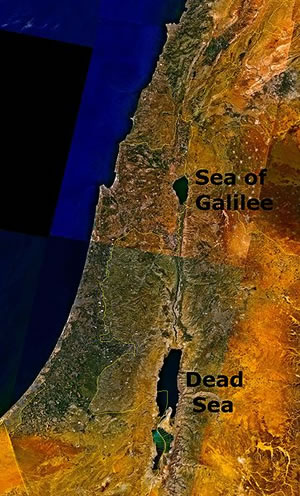It is eight times as salty as normal seawater. While normal seawater has a salt content of 3.5 percent, the Dead Sea is 28 per cent salt.
In comparison, the Great Salt Lake in Utah is six times as salty as normal seawater.
The Dead Sea's saltiness is responsible for the lake's best known feature: its buoyancy Sinking and diving are impossible, but it is far easier to swim or float here than in any other stretch of water.
 The River Jordan, together with many small streams, feeds the Dead Sea with water and minerals from the surrounding hills. However, the lake has no outlet; its water escapes exclusively by evaporation, leaving behind a concentrated solution of salts, especially magnesium chloride, sodium chloride and potash.
The River Jordan, together with many small streams, feeds the Dead Sea with water and minerals from the surrounding hills. However, the lake has no outlet; its water escapes exclusively by evaporation, leaving behind a concentrated solution of salts, especially magnesium chloride, sodium chloride and potash.
The average annual rainfall is 10cm (4in). However, almost 2m (6.6ft) of water is lost in evaporation.
Lowest Point on Earth
The lowest point on the Earth's land surface, the shores of the Dead Sea are 396m (1,300ft) below the level of the Mediterranean Sea, only 75km (47mi) away. The depression in which these waters sit lies near the northern end of the Great Rift Valley.
This rift system is an immensely long trench that zigzags its way 6,500km (4,060mi) from Syria to Mozambique. It began to form around 25 million years ago when movements in the Earth's crust caused the land to subside.
Dead Sea Life
Almost no forms of life can survive in the Dead Sea, because of its high level of salinity. However, a few microorganisms do flourish there.
A single-celled organism, known as Heliobacterium halobium, is so dependent on the Dead Sea's salt concentrations that if the Dead Sea were diluted to only three times the strength of seawater, it would die.
Heliobacterium halobium contains a unique purple pigment, called bacteriorhodopsin, that traps sunlight in a way similar to the chlorophyll of green plants.
Pillars of Salt
Around two million years ago, the Mediterranean Sea covered the region around the Dead Sea. Rock salts were deposited in enormous quantities and, as the Mediterranean receded, these were laid down in the hills and mountains.
The Jebel Usdun, a range of hills at the Dead Sea's southern end, is composed of almost solid rock salt. A cap of gypsum and chalk has prevented the infrequent rains from washing away the salt completely.
Rising to a height of 150m (500ft), the Jebel Usdun runs for nearly 9km (5.6mi), its steep sides furrowed and chiseled by wind and water.
Freestanding pillars of salt are a characteristic of the Jebel Usdun. In Genesis 19, the Bible says that Lot's wife was turned into a pillar of salt after turning to view the destruction of Sodom and Gomorrah. Legend says that the ruins of Sodom and Gomorrah lie under the waters of the Dead Sea's southern basin.